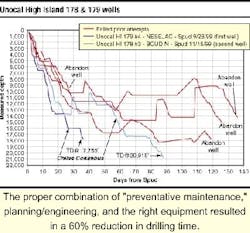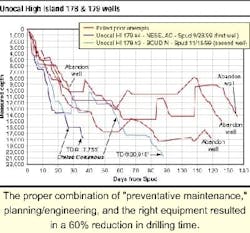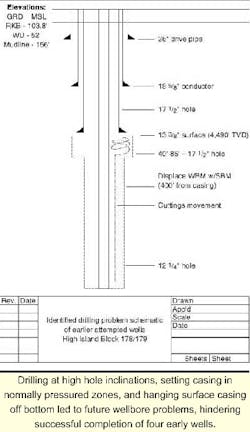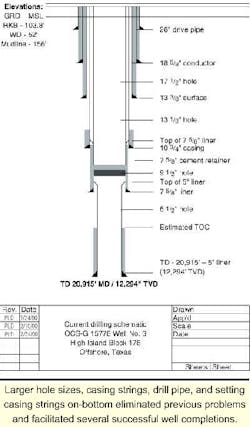Wellbore cleaning, high hydraulic hp critical in High Island HT/HP wells
PART II: This is the second in a two-part series presenting drilling engineering best practices for tackling tough HP/HT shallow water projects around the world. Part I focused on a new large jackup drilling rig design and associated enhancements to tackle this niche market. Part II focuses on HP/HT wells drilled successfully in a known well construction problem area of the Gulf of Mexico (High Island).
Good drilling engineering always cont-ributes to successful well construction projects, but where does it take a commanding role: in the planning phase or the on-the-fly engineering decisions during well construction?
To some, there should be a healthy mix of both, but there is a strong argument that engineering in the planning stages directs the decision-making process of the later, on-the-fly decisions, yielding a higher potential for success.
Asset teams around the world use different planning approaches in designing and engineering well construction. Many companies, capitalizing on the specific skills and knowledge of their geological and engineering experts, use multiple-team approaches for well planning and execution activities. This can be beneficial, but in the case of high-risk wells with a history of drilling problems, this may not be the best alternative.
A one-team approach may work more effectively. Unocal has adopted this philosophy for attacking difficult HP/HT Gulf of Mexico wells, citing adaptability and ease in on-the-fly engineering decisions as two advantages in achieving well objectives.
Prior attempt lessons
Unocal approached Chiles Offshore LLC for assistance in drilling in two High Island blocks where operators had failed in completing wells in four different attempts. The combination of fundamental preventative well planning, the use of enhanced-capability rig equipment, and a strong confidence in their planning and drilling engineering processes, all contributed to Unocal's success in several succeeding wells drilled in the same block.
The High Island blocks, 178 and 179, are two fault block reservoirs located under a maritime shipping right-of-way. The less than optimum placement of a drilling rig to access the reserves usually resulted in difficult directional drilling situations. Previous exploration drilling attempts in each of the two blocks resulted in four wells unsuccessfully reaching total depth (TD).
Planning, more planning
The planning process for Unocal's well construction operations began with a scope and cost analysis of the four previous wells, with a summary of each. From the summaries, areas of potential improvement were identified, and a "Key Issues to Success" document derived to effectively drill wells in these difficult blocks.
The resulting "Nine Keys to Success" document revealed distinct differences, from the earlier failed attempts, in well planning and engineering:
- Rig selection
- Use of mud line hangers
- Casing and hole size incompatibility
- Kick-off point
- Drill pipe selection
- Casing point selection
- Hole exposure time and enlargement
- Loss circulation
- Hole cleaning.
Keys to success
(1) Rig selection: Rig selection was important because hole cleaning was one of the key issues to success. Readily available hydraulic horsepower was considered critical, since hole cleaning could not be compromised. The Chiles jackup rigs, equipped with three of the largest mud pumps available and a 7,000 psi manifold, allowed the rig to operate normally with one pump down for repairs.
The rig - Chiles Offshore LeTourneau Super 116 rig design - had advantages with greater variable deckload capabilities. George Armistead of Unocal explained: "The deck is so big, and the variable deck load so large, the question - 'Is there sufficient space available?' - was never asked. Ample space for casing and extra synthetic mud and cuttings boxes was never an issue."
The automated driller's console was beneficial in the increased sensitivity to well conditions. The digital weight indicator gave a much better feel of wellbore conditions." As an example, monitoring the well from the onshore office, the drilling engineer was able to observe in real-time problems with connections and pumping. The operator had a better feel for critical points in the drilling process. The no-discharge rig also had more than enough mud volume capability to handle the 20,000 feet plus wells.
(2) Mud line hangers: The decision to run surface casing all the way to total depth was made based on well construction problems observed in earlier wells. Earlier attempts had used mud line hangers for a 13 3/8-in. surface casing string. Some operators will use this technique to decrease weight of the casing string transferred to the surface facility.
These wells landed the 13 3/8-in. casing in a 17 1/2-in. hole, 50-85 ft off bottom, leaving excess 17 1/2-in. rathole below the casing shoe - a hole section that would not just go away. The 17 1/2-in. rathole above the succeeding 12 1/4-in. hole, created a cuttings settling area just below the shoe, resulting in cuttings dropping out and re-circulating and swirling around in the annulus. The greatly reduced annular velocities in this larger rathole resulted in the hole problems observed in earlier wells. Unocal's approach of setting casing on bottom, even the conductor casing in this particular case, helped to reduce these lost circulation and cuttings movement problems.
(3) Casing and hole size in-compatibility: Earlier well attempts resulted in the drilling of an 8 1/2-in. hole below a 9 5/8-in. intermediate string. Seven inch and 7 5/8-in. casings were then run in the 8 1/2-in. hole. Hydraulic and well directional analysis suggests there was a strong likelihood of cuttings bed buildup on the bottom of this 8 1/2-in. hole, restricting ability to successfully land the casing. To improve casing running success, Unocal decided to drill a 9 1/2-in. hole below 10 3/4-in. intermediate casing, then run a 7 5/8-in. production string. A centralized float shoe and collar, along with straight blade centralizers on bottom, were also used to avoid any plowing effect in front of the casing. Surge pressures and simple wellbore friction problems were minimized, and easier installation of the casing observed.
(4) Kick-off point: Some of the earlier wells kicked off below surface casing yielded long hole sections with hole angles greater than 70 degrees. Severe hole cleaning problems were the result. To reduce these problems, kick off points were planned just below conductor casing, allowing for most of directional work to be done at the top of the well, and keeping the maximum hole angle to TD around 60 degrees. The philosophy was to minimize the amount of directional corrections at more difficult deeper depths and higher temperatures.
This contrasts with the common practice of avoiding the taboo 55-65 degree hole inclination range. Cuttings bed avalanches, common to this hole orientation, were considered less of a problem than the drilling problems often encountered in a 70 degree or greater well. The improved hydraulics of the proposed tubular hole size and casing size combination worked to reduce the cuttings movement and hole cleaning and tubular tripping problems anticipated in the 55-65 degree well path. The idea was to minimize the chances of excessive time spent in hole remediation operations, such as back-reaming and excess hole circulation, before trips out of the hole.
(5) Drill pipe selection: All previous wells were drilled with 5-in. drill pipe. Unocal decided to use 5 1/2-in. drill pipe to maximize flow rates (at lower stand pipe pressures), hole cleaning (maintaining greater annular velocities than earlier wells), and ROP. Following the original "preventative maintenance" approach to the well planning process, chances of a washout in the drillpipe and a possible mistake in drill pipe make-up were minimized.
(6) Casing point selection: In earlier wells, casing points were selected in normally pressured geologic sections of the well. This resulted in later lost circulation problems in the normally pressured sands. The remedy was to set casing in the established straight-hole, field pressure transitions.
(7) Hole exposure time, enlargement: Any way to minimize hole exposure time and remediation activities was seen as an area of potential cost savings. Some of the wells were kicked off below the surface casing, requiring more aggressive and time-consuming directional work. This, and hanging casing off bottom, left critical areas of the wellbore exposed for extended periods of time.
In one of the previous wells, water based drilling fluids (WBM) were not displaced with an oil-synthetic base system (SBM) until 400 ft outside of casing in earlier wells. This exposed the enlarged 17 1/2-in. hole and over 300 ft of 12 1/4-in. hole to water based fluids, creating hole problems in the area below the casing shoe. The solution to this problem was setting a 13 3/8-in. surface casing string on bottom - deeper than necessary, minimizing the amount of open hole for the succeeding critical hole problem section - and displacing to synthetic fluids before drilling out of casing.
The use of bi-center bits allowed Unocal to drill a 13 1/2-in. hole with better than anticipated rilling performance. Directional drilling performance was not hindered in any way during the drilling of this hole section, with ROP's recorded of over 300 ft/hr. This also worked to greatly reduce the hole exposure time.
(8) Lost circulation: Two previous wells in the High Island 179 block experienced lost circulation problems in normally pressured sands and near the casing shoes. To minimize a repetition, and to avoid loss of returns after beginning directional work, the conductor casing shoe was tested before drilling the surface hole. As extra insurance against mud loss in the anticipated massive sands of the intermediate hole, lost circulation material was incorporated in the synthetic based mud before drilling out.
Equivalent circulating density (ECD) was a key factor of consideration in these wells with a high potential for lost returns. The previous long reach wells indicated that high ECD's would be encountered. Simple wellbore geometry created a 100% increase in ECD. The pressure loss of moving the mud along the 20,000 feet, higher angle, and open wellbore were the main contributors to this ECD increase. The 10 3/4-in., intermediate casing string and 9 1/2-in. hole combination of the re-engineered wells, greatly reduced the ECD over the same geologic interval. An approximate 30% reduction in ECD was realized.
Mud system critical
The choice of mud systems played a key role in the success of these wells. Water based systems in known difficult geology, with an associated aggressive directional well construction plan, can often lead to problems. The sensitive chemical nature of these fluid systems, makes them highly susceptible to operator error, such as adding wrong chemical, additive, or water volume.
To minimize the chance of operator error in a critical part of the well, a synthetic based mud system was used. Improved mud system consistency and hole stability maintenance were observed. The oil-wet nature of the mud system and formation eliminated the chemical effect occurring with water-wet systems.
Practical re-engineering and the right equipment are the main reasons for the success of these, and later, wells drilled in these "problem" blocks. The one-team project management and a preventative maintenance approach to the well planning and execution processes also were contributors. The saying, "When all else fails, go back to the fundamentals" definitely was appropriate in this situation.
Author
George Armistead is a Drilling Engineer for Unocal, with greater than 25 years experience in Gulf of Mexico as an engineer and project manager.



